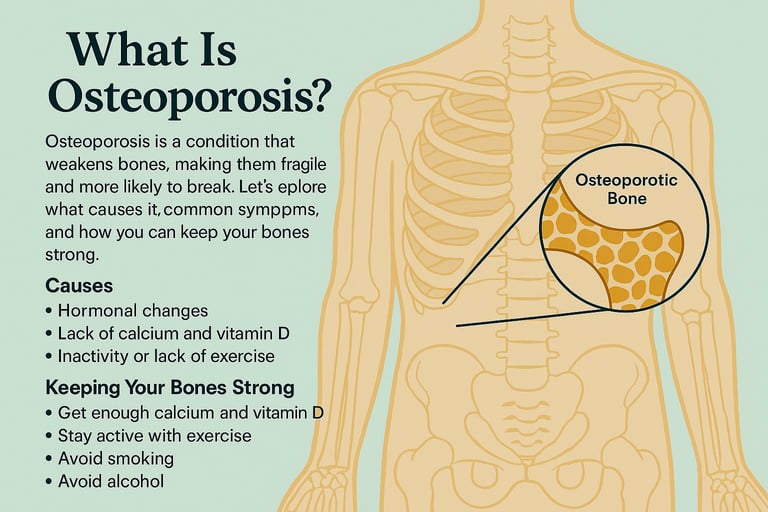Stay updated on what is trending in health. Discover tips and resources for a healthier, balanced life.
What Is Osteoporosis? Causes, Symptoms & How to Keep Your Bones Strong
Learn what osteoporosis is, its causes, symptoms & bone protection tips. This easy guide offers practical advice for understanding and maintaining bone health.
DISEASES AND CONDITIONS
Dr. S. Ali
9/7/20253 min read


What Is Osteoporosis?
Osteoporosis is a condition that weakens your bones, making them fragile and more likely to break. The word “osteoporosis” literally means “porous bone.” It develops when your body loses too much bone, doesn’t make enough new bone, or both. This imbalance causes bones to become thin, brittle, and less dense—so much so that even a minor fall, bump, or even a sneeze in severe cases can lead to a fracture.
Osteoporosis is often considered a natural part of aging, especially for women after menopause due to the drop in estrogen levels, which plays a key role in maintaining bone density. However, it can also affect men and even younger individuals, especially if they have risk factors such as certain medical conditions, medications, or poor lifestyle habits. While aging increases your risk, osteoporosis is not inevitable—and many steps can be taken to prevent or manage it.
Who’s at Risk?
Osteoporosis can affect anyone, but certain groups are more at risk:
Women over 50 (especially after menopause)
Men over 70
People with a family history of osteoporosis
Individuals with low body weight or small frames
People with medical conditions like rheumatoid arthritis or thyroid disorders
Long-term users of steroids or certain medications
Common Signs and Symptoms
Osteoporosis is often called a “silent disease” because you might not notice any symptoms until a fracture occurs. But here are a few signs to watch for:
Loss of height over time
Back pain, often caused by a fractured or collapsed vertebra
Stooped posture or a hunched back
Bones that break more easily than expected
What Causes It?
Your bones are constantly being broken down and rebuilt. As we age, the rebuilding process slows down. Factors that contribute to osteoporosis include:
Hormonal changes, especially in women after menopause
Lack of calcium or vitamin D
Lack of physical activity
Smoking and alcohol use
Certain medications, such as corticosteroids
How Is Osteoporosis Diagnosed?
The bone density test (DEXA scan) is the primary and most reliable test for diagnosing osteoporosis. However, doctors may also order additional tests to rule out other conditions or determine the underlying cause of bone loss, especially if the patient is younger or has unusual symptoms. These may include:
Blood tests – to check levels of calcium, vitamin D, thyroid function, and markers of bone turnover
Urine tests – to assess bone breakdown
X-rays – not used to diagnose osteoporosis directly, but may reveal fractures or bone thinning
FRAX score – an online tool that calculates fracture risk based on several factors
So while the DEXA scan is the main diagnostic tool, your doctor may use these other tests to get a full picture of your bone health.
Treatment Options
While osteoporosis can’t be completely cured, it can be effectively managed with the right approach. The goal of treatment is to strengthen bones, prevent fractures, and maintain mobility and independence. Common treatment options include:
Calcium and Vitamin D Supplements
These nutrients are essential for bone health. Calcium helps build and maintain strong bones, while vitamin D improves bone formation and also calcium absorption.Prescription Medications
Your doctor may prescribe medications such as bisphosphonates to slow down bone loss or newer treatments like teriparatide or denosumab that help build bone.Weight-Bearing and Muscle-Strengthening Exercises
Activities like walking, climbing stairs, dancing, and light strength training can help maintain bone density and improve balance, reducing your risk of falls.Fall Prevention Strategies
Simple changes around your home—like removing loose rugs, using non-slip mats, installing grab bars, and keeping rooms well-lit—can significantly lower your risk of falls and therefore, fractures.Lifestyle Changes
Quitting smoking, avoiding alcohol, and maintaining a healthy weight are all important steps in supporting bone health and slowing the progression of osteoporosis.Regular Monitoring
Bone density tests (DEXA scans) are often repeated every 1–2 years to monitor your progress and adjust treatment if needed.
How You Can Keep Your Bones Strong
Taking care of your bones is important at every age. Here’s what you can do:
Eat a balanced diet rich in calcium (dairy, leafy greens, almonds) and vitamin D (sunlight, fatty fish, fortified foods)
Stay active with weight-bearing and resistance exercises
Avoid smoking and avoid alcohol
Get regular checkups, especially if you have risk factors
Prevent falls by keeping your home safe and using assistive devices if needed
Final Thoughts
Osteoporosis may sound scary, but the good news is that you can take steps to prevent it or slow its progress. Early detection, healthy habits, and the right treatment plan can help you live an active, independent life with strong bones.
Related Articles:
1. 5 Natural Hypertension Tips for a Healthier You
2. Waist Circumference is a Stronger Predictor of Obesity-Related Cancer Risk Than BMI in Men
Sources:
1. National Institute of Arthritis and Musculoskeletal and Skin Diseases (NIAMS)
https://www.niams.nih.gov/health-topics/osteoporosis
2. Centers for Disease Control and Prevention (CDC)
https://www.cdc.gov/nchs/fastats/osteoporosis.htm
4. National Institute on Aging (NIA)
https://www.nia.nih.gov/health/osteoporosis
Pulse Your Health
Empowering you to achieve your health goals.
Contact
© 2025. All rights reserved.
Disclaimer: The content on this website is for informational purposes only and is not medical advice. Always seek the advice of your physician or other suitably qualified healthcare professional for diagnosis, treatment and your health related needs.
